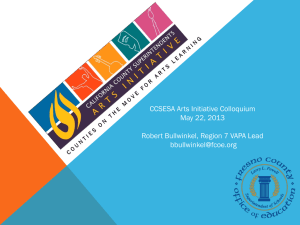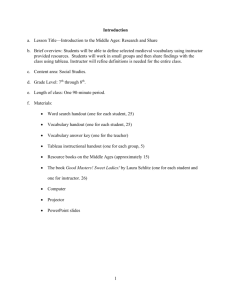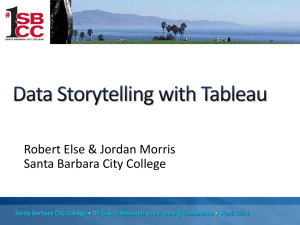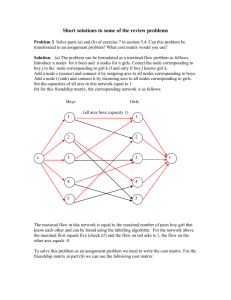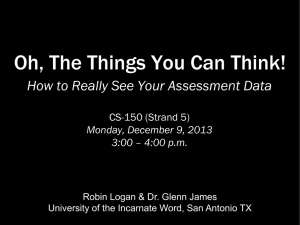Solution Middle Ages Vocabulary
advertisement
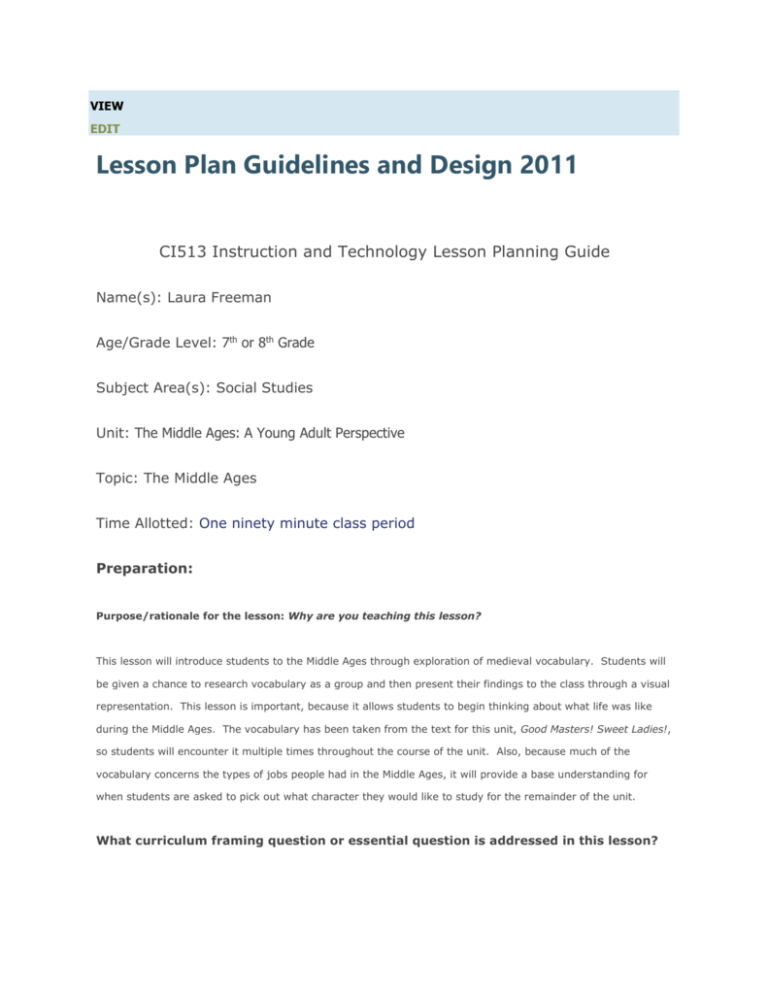
VIEW EDIT Lesson Plan Guidelines and Design 2011 CI513 Instruction and Technology Lesson Planning Guide Name(s): Laura Freeman Age/Grade Level: 7th or 8th Grade Subject Area(s): Social Studies Unit: The Middle Ages: A Young Adult Perspective Topic: The Middle Ages Time Allotted: One ninety minute class period Preparation: Purpose/rationale for the lesson: Why are you teaching this lesson? This lesson will introduce students to the Middle Ages through exploration of medieval vocabulary. Students will be given a chance to research vocabulary as a group and then present their findings to the class through a visual representation. This lesson is important, because it allows students to begin thinking about what life was like during the Middle Ages. The vocabulary has been taken from the text for this unit, Good Masters! Sweet Ladies!, so students will encounter it multiple times throughout the course of the unit. Also, because much of the vocabulary concerns the types of jobs people had in the Middle Ages, it will provide a base understanding for when students are asked to pick out what character they would like to study for the remainder of the unit. What curriculum framing question or essential question is addressed in this lesson? How does society shape the individual? What district, state or national curriculum standard(s) will you target in this lesson? SS.08.HS.05.05 Understand the major developments and societal impact of feudalism, the church, and the rise of cities in the European Middle Ages. Prior Knowledge/Background Information: What concepts and/or skills do students need to have in order to be successful in this lesson Students need to: Have experience using tableau. Know how to work cooperatively in groups. Comprehend the previous unit: The Rise and Fall of the Roman Empire Understand how to use a text in order to locate a specific definition of a word. Learning Objectives for the lesson: What do you expect learners to know and/or accomplish as a result of participating in this lesson? How are you incorporating higher order thinking? Students will be able to: Define given medieval vocabulary. Provide a visual explanation of vocabulary using tableau. Begin thinking about what life was like in the Middle Ages for certain characters. Understand the importance of careers in the Middle Ages, and the importance of how occupation defines the individual at this point in history. Key Concept(s): What concepts (related to content and/or process) will students encounter as a result of this lesson? The importance of occupation in the Middle Ages. The various terms and words used to define people and things in the Middle Ages. How to successfully work in a group to convey a message. Key Question(s): What questions/prompts will you build into your lesson plan to foster student engagement and higher order thinking? What job would you want to have in the Middle Ages? Why? What types of facial expressions would someone have in the Middle Ages if they were a villien, lord, or falconer? What was someone your age doing in the Middle Ages? Does your job define who you are as a person? Materials/Resources Needed: Word search handout (one for each student, 25) Vocabulary handout (one for each student, 25) Vocabulary answer key (one for the teacher) Tableau instructional handout (one for each group, 5) Resource books on the Middle Ages (approximately 15) The book Good Masters! Sweet Ladies! by Laura Schlitz (one for each student and one for instructor. 26) Computer Projector PowerPoint slides Procedures:Overview of the lesson and time estimate for each component. Include expanded descriptions of what the teacher and students are doing. Hook or Anticipatory Set: Introduction - how will you ‘grab’ students’ attention and get them ‘set’ for learning? As a hook, I have decided to use a word search of the vocabulary they will be encountering. This is a great introduction, because it is a low pressure activity. Also, the fact that students are not working together for the portion of the lesson allows students to calm down and focus on the task at hand. Body of the lesson: Major items or activities in the order they will occur. Intro/Look Back: 1. (5 minutes). T: Welcome good masters and sweet ladies! Last week we saw the fall of the mighty Roman Empire, and now we will be moving on to Europe’s Middle Ages. Specifically, we are going to examine what daily life was like in a medieval village. Our studies will center around Laura Amy Schlitz’s book “Good Masters! Sweet Ladies!,” but before you are given the text, and learn a little more about it, we are going to start with an activity. Through 2. (10 Minutes). Pass out word search. Allow ten minutes for students to find the vocabulary. At the end of ten minutes tell students it is alright if they have not found all the words, and they can always continue searching if they have any free time later. If time, teacher can ask student how many of them managed to find more than five, ten, fifteen, etc., by a show of hands. 3. (5 Minutes). Divide the class into five groups; each group will have five members. This will be done by going around the classroom and numbering students one through five. 4. (5 Minutes). Divide the vocabulary from the word search among the groups. One group will only be responsible for three words. Pass out pile of books to students each group will have three or four sources to use for finding answers. Teacher will have already gone through books and make sure words can be found in books. The words they research depend on what stack of books they receive. a. T: As a group, I want you to come up with definitions for the each of the words you are responsible for finding. Write the words along with the definitions down on a piece of paper. This paper will be handed to the instructor, so make sure it is legible. Once you have found all the definitions please raise your hand and I will come and collect the group paper. We will then be shifting into one of the class’s favorite activities— tableau. 5. (35 Minutes). Allows students to research. Teacher will walk around the room to make sure that students are staying on track. Teacher will also make sure to answer any questions and provide guidance and hints if needed. a. Possible leading questions: i. Have you already checked the index? ii. Some books have a glossary? iii. What can the chapter titles tell you? iv. Browse through the pictures, do any of them seem to be related to the word you are trying to find? When each group finishes, instructor will take definitions and give tableau handout. Students will be asked to think about what word they would like to represent through a tableau. 6. (5 minutes). Teacher gets the attention of the entire class. T: It appears that everyone has finished with their research. Great job and thank you for staying on task. Your group is now in charge of using one vocabulary word to create a tableau. We all have done tableaus in the past, but I have handed out a reminder of key points to consider while composing your tableau. You have five minutes to work before sharing with the class. 7. (15 minutes). Students are asked to share their tableau with the rest of the class. Each group has told the instructor the word they will be using, and the instructor puts the definition and the word on a PowerPoint slide while the students are preparing to share their tableau. During each tableau the instructor asks the viewing students: a. What is going on in the scene? b. Are different levels being used? c. What is the focal point? d. Are the students displaying strong emotions? e. Is there any tension between tableau characters? f. What do you think the word might be? At the end of each tableau the instructor will display the word and definition on the projector using the PowerPoint slides. Beyond 8. (10 minutes). Hand out texts. T: Thank you for sharing your creative and entertaining tableaus. The vocabulary you have been using was not randomly selected, but was taken from your text for this unit. We will be using Good Masters! Sweet Ladies! by Laura Amy Schlitz. Ms. Schlitz is a librarian, playwright , and storyteller who created this book of medieval monologues for her school when she saw that there was nothing like it available. I am now going to read you a list of the characters and a short description of each, and your exit slip today will be the top three stories you are interested in working with for this unit. At the start of the next class I will also hand you a paper with all of the definitions next class and we will have a short review. a. Short descriptions found on the back of Good Masters! Sweet Ladies! Extensions/Differentiations: How will you adapt this lesson for students with cultural, linguistic, and cognitive differences? The books the students will be using to conduct research all include a number of pictures along with the vocabulary. I have used Eyewitness books and others like it for this portion of the project. Also, because the students are working in groups, they can help each other by explaining the vocabulary to those who are having difficulty comprehending. The tableau aspect of the lesson plan is helpful as well, because it encourages students to provide a visual representation for their classmates to analyze, question, and comprehend. Attention to Literacy: How is literacy addressed in this lesson? Literacy is addressed in this unit through the use of Eyewitness style books. The vocabulary is heavily supported with imagery. Assessment: Evaluation of student learning: How will you determine what progress the students have made toward accomplishing the learning objective(s)? How will higher order thinking be incorporated into your assessment of student learning? What criteria will you use? a. Students will be evaluated through the activity of tableau. I have found a tableau rubric, and it will be given to the students. b. Students will be evaluated by teacher throughout the entire process. While the students are researching, the teacher will visit each group a number of times to ensure that they are staying on task. c. Students will be evaluated with through the group paper that is turned in with vocabulary definitions. It must be: i. Legible ii. Thoughtfully written iii. Show students conducted thorough research Reflecting on the teaching process: (To be completed after the lesson is developed and/or taught) 1. What worked well? What would you do differently to improve the lesson? Since I have not yet taught this lesson, I only can reflect on the lesson plan I have created. I am most concerned about timing. I hope that the lesson is not rushed for the students. Also, I want to tweak the lesson in order to fit the students, I have not yet met the class I will work with, but I will always keep in mind that no lesson is perfect and can be adjusted. 2. What went through your mind as you planned this lesson? What questions do you still have about the lesson? As I wrote the lesson, I continually asked myself if the students would be engaged. I want to make the subject as interesting and fun as possible, while still making sure the students are learning and interacting with the material provided. 8/2/2010 Portland State University Graduate School of Education 2 Sample Handouts: Middle Ages Vocabulary G N I B M A L N C L F P D P M R W Y I A APPRENTICE CRUSADE FALCONER FALLOW FEUDAL FISHMONGER LAMBING MANOR MAYLING MILLER PILGRIM PLOWBOY POTTAGE RELIC SARACENS SNIGGLER TANNER VARLET VILLEIN M P N O Q L I Z M Z E L S L J D E W J Y A Y V P Z E N J N Q X N L O K X X W K B R P V N L N I M V K E X T W T Q N J H T E K P L P P J J D C A C R B Y Z Z R K Q N W I R S A C F A W H I C O P E X O L F O V Z C E R M R F M L I C Y D C Q E L G C N C Z U N A W O L L A F M A N O R Q L L M I S N S T M B E F I S H M O N G E R A Z A H Z S K I R D Y C G B K E U Q D B F D P V V R E W C N T U T Q V G G O M S E Z X F Q W R G K E L A Q D P A F G D O J E X S G J T E I E N A D D H T T O M K V P I L G R I M L N M G D I W T S G I R O A T G P I B Q E G S A I U U O V R L L U Y R T Q B X R G A G V Y A E P R F L T H T H L E G D J F J J I Q L X F C W E X E K I G E U O C N L P A N N I I K Y R C L R H L T T S E H S O V C S C N V Z L T H C R T Y M V D M P E M A Y J F G O J Q Created through: http://www.discoveryeducation.com Solution Middle Ages Vocabulary G N I B M A L N + + + + + P + + + + + + + + + + + + I + + + + + S L + + + + + + A + + + + E + + + + + N + O + + + + + + R P + + L + + + + + E + + W + + + + + + E + P L + + + + + C + + + B + + + + + + N + I R + + C + A + + + C O + + + + + + O V + + E R + R + + + I + Y + + + + + + C + + + U N A W O L L A F M A N O R + + L + + S + S T + + E F I S H M O N G E R A + A + + + + I R + + + + + + E + + + + F D + + + + + + C + + + T + + G + + + + E + + + + + R + + E L A + + + A + + + + + + + + + + + E + + N A + + + T + + M + V P I L G R I M L N M + D + + T + + I + + A + + + + + + E G + A + U + O + + L + + + R + + + + R + + G + Y + E P + + L + (Over,Down,Direction) APPRENTICE(3,1,SE) CRUSADE(6,7,NE) FALCONER(11,1,W) FALLOW(8,13,N) FEUDAL(17,16,NW) FISHMONGER(9,11,S) LAMBING(1,7,N) MANOR(8,14,S) MAYLING(14,11,SE) MILLER(13,19,E) PILGRIM(14,2,S) PLOWBOY(1,14,E) POTTAGE(16,16,W) RELIC(10,9,SW) SARACENS(9,6,SW) SNIGGLER(19,14,NW) TANNER(11,13,NE) VARLET(14,1,SE) VILLEIN(7,2,SW) + + + L + + + + + + + I + L + F + + E + + + + + E + + + + + + + N + I + + + R + + + + + + T + + + + + + + S + N + + + + + + + + + + + + + + + + + + + + G + + + Medieval Vocabulary Reference Sheet These definitions can be altered depending on what the students find in their research. APPRENTICE: Someone who works for a skilled or qualified person in order to learn a trade or profession, esp for a recognized period CRUSADE: Any of the military expeditions undertaken by the Christians of Europe in the 11th, 12th, and 13th centuries for the recovery of the Holy Land from the Muslims. FALCONER: A person who engages in the art of keeping falcons and training them to return from flight to a lure or to hunt quarry FALLOW: Plowed and left unseeded for a season or more; uncultivated. FEUDAL: The feudal system is the political, military, and social system in the Middle Ages, based on the holding of lands in fief or fee and on the resulting relations between lord and vassal. FISHMONGER: A retailer of fish LAMBING: The shepherd's work of tending the ewes and newborn lambs at this time MANOR: A landed estate or territorial unit, originally of the nature of a feudal lordship, consisting of a lord's demesne and of lands within which he has the right to exercise certain privileges, exact certain fees, etc. MAYLING: A tract of land rented by a mailer; a rented farm or smallholding MILLER: A person whose trade is the grinding of corn in a mill; the proprietor or tenant of a corn-mill. Also, a person in a mill who has charge of the actual grinding. PILGRIM: A person who makes a journey (usually of a long distance) to a sacred place as an act of religious devotion. PLOWBOY: A boy who leads the animal or animals drawing a plough, a boy who drives a plough; (hence more generally) a boy from a rural labouring class, a country boy. POTTAGE: A thick soup or stew, typically made from vegetables, pulses, meat, etc., boiled in water until soft, and usually seasoned. RELIC: In the Christian Church, esp. the Roman Catholic and Orthodox churches: the physical remains (as the body or a part of it) of a saint, martyr, or other deceased holy person, or a thing believed to be sanctified by contact with him or her (such as a personal possession or piece of clothing), preserved as an object of veneration and often enshrined in some ornate receptacle. SARACENS: Among the later Greeks and Romans, a name for the nomadic peoples of the Syro-Arabian desert which harassed the Syrian confines of the Empire; hence, an Arab; by extension, a Muslim, esp. with reference to the Crusades. SNIGGLER:A sniggler is a person who is engaged in sniggling. Sniggling is the action or practice of fishing for eels by means of a baited hook or needle thrust into their holes or haunts. TANNER: One whose occupation is to tan hides or to convert them into leather by tanning. VARLET: A man who looks after the animals; usually for the lord of the manor. VILLEIN: A peasant who is not free. Can be bought and sold like a slave. House, family, and labor all belong to the lord of the manor. Tableau: Key Points to Remember Tableau: a silent, motionless depiction of a scene. A convention in which members of a group use their bodies to make an image or picture capturing an idea, theme, or moment in time, also called a group sculpture, freeze frame, still image, or picture window. Tableau criteria-students should: 1. Display a character's sense of excitement, anticipation, suspense, and other emotions with exaggerated facial expressions, gesture, and body position. 2. Have a shared focal point within the group. 3. Use a variety of levels when expressing their physicalizations. 4. Create some level of physical tension between characters. 5. Use all available clues provided by the author of the text. Colorful character descriptions, mood indicators, and action verbs are most helpful. Tableaus should answer the following questions (the 5 Ws): Who are the characters? Where are the characters? Why did they come together? When did the characters come together? What is happening to these characters and what will happen to these characters next?
